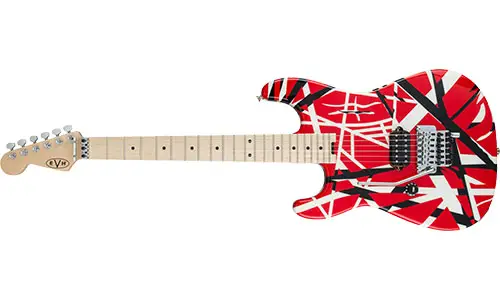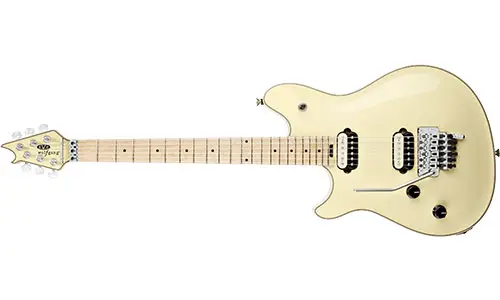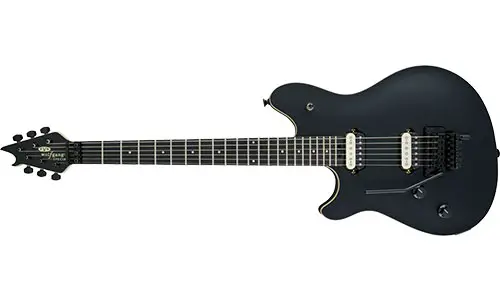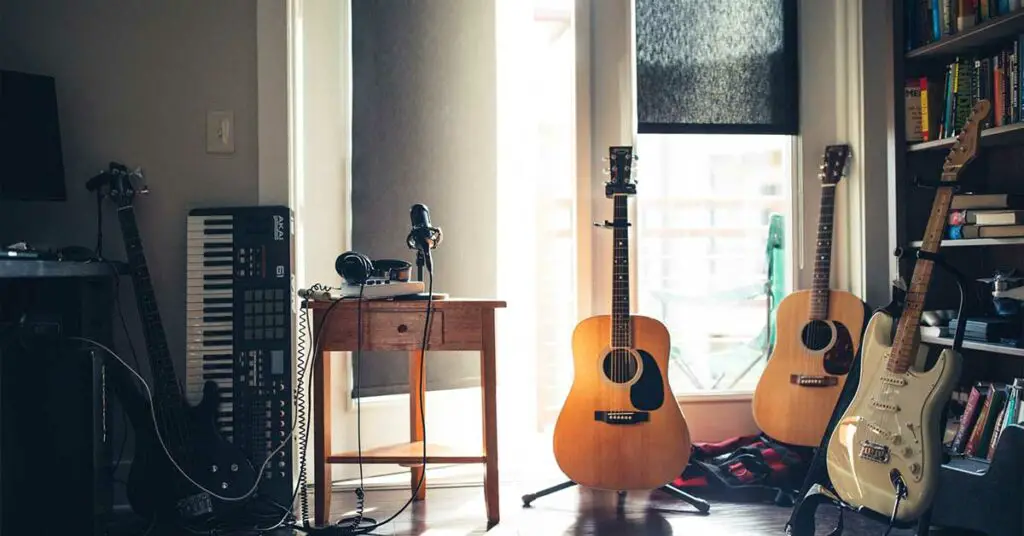Being left handed can be difficult. Traversing day to day life in a world made for right handed people means you have to adapt and figure out how to do things your own way.
Yes, some things may be difficult, but you can rest assured that if you ever want to pick up a guitar, there are options out there!
EVH has a selection of left handed guitars to fit all kinds of styles, and it makes it a lot easier for left handed folks to learn how to play without the difficulty of trying to play right handed.
We’re going to go through the different left handed guitars EVH has to offer, but first we’ll talk about some of the reasons left handed guitars might be hard to come by, and the history around “upside down” guitars.
Bruce Dickinson, head of the Brighton Institute of Modern Music, says:
“I’ve seen many lefties who play right handed and have difficulties later on because their picking/strumming hand is the less sensitive and controlled of the two.
Typically, if they are full left handed their sense of rhythm in the right hand will be less developed or just unmanageable.
This problem, which does not build up until later along the learning curve, can be an insurmountable obstacle. This is why I don’t recommend that left handers learn to play right handed unless they feel very comfortable with it ” (x).
Remember that whatever instrument you choose, your play style and comfortability doesn’t have to look like any specific way.
As you’ll see a little later on, you’ll see that many famous musicians even modified their guitars in order to fit their play style.
Table of Contents
Playing Left Handed
There are actually a lot of different ways that left handed musicians can play their instruments.
They can play either the guitar or the electric base in one of the following: playing the instrument truly right-handed, play the instrument truly left-handed, altering a right-handed instrument to play left handed, or turning a right-handed instrument upside down to pick with the left hand, but not altering the strings- leaving them reversed from the normal order.
Any style of picking with the left hand, like flatpicking or fingerstyle guitar, is considered playing left handed.
Normal Stringing
Guitarists who are left-handed and have the normal stringing on their guitars pick with their left hand and have the strings in the conventional order for a left-handed player.
This means that the low string is on the top side of the neck. They either have true left-handed guitars or have right-handed guitars altered so the strings are correct for a left-handed player.
Some guitarists in this category play both genuine left-handed instruments and right-handed instruments altered for left-handed playing.
One such musician in this category is Paul Mcartney, who took up being the bassist of The Beatles and used a left-handed Hofner 500/1 guitar that became popularly used in lots of their songs.
McCartney first struggled playing right-handed, but then saw a picture of Slim Whitman playing left-handed and realized that he could reverse the guitar, reverse the strings, and pick with the left hand.
Slim Whitman, for his part, was actually right-handed but because he lost two fingers on the left hand, he played left-handed.
Changing the strings on a right-handed guitar involves several things, including changing the nut of the guitar to accommodate string widths, or changing the bridge to make the lower strings longer than the top strings for correct intonation.
On almost all acoustic guitars, the bracing is non-symmetrical. If you alter an electric guitar this way, the controls will be backwards.
Some notable musicians besides Paul McCartney who play this way are Al McKay (of Earth, Wind & Fire), Billy Ray Cyrus, and Courtney Barnett.
Paul Gray from Slipknot started out playing right-handed, then changed to left-handed as it was more comfortable for him.
Strings Backwards
Musicians in this category play naturally left-handed, but in this case they organize their strings to emulate an unaltered right-handed guitar, so the strings are backwards for a left-handed player.
The guitar is held left-handed with the high string on the top side of the neck. Some musicians in this category had left-handed guitars with the strings as on a right-handed guitar, since they had learned to play that way.
Some famous musicians in this category include Amber Bain, Glen Burtnik, and Eddy Clearwater.
Other Left Handed Instruments
Aside from guitars, one can set up a few different instruments to be played left-handed. A drum kit, for example, can be set up for left-handed playing.
The musician would set it up so that percussion instruments that would normally be played with the right hand, like the ride cymbals, the floor tom, etc.
The bass drum and hi-hat configurations are also set up so that the drummer plays the bass drum with their left foot, and operates the hi-hat with their right foot.
If they’re using two bass drums, they play the second bass drum with their right foot. Some drummers have been known to play right-handed kits, but play leading with their left hand (this is like playing open-handed on the hi-hat).
Drummers like Chris Adler and Ringo Starr are naturally left-handed while playing drums purely right-handed.
Things like the violin can be learned in either hand, and most left-handed players hold the violin under the left side of their jaw, the same as right-handed players. This allows all violinists to sit together in an orchestra.
Why is it so hard to find a left handed guitar?
If you think that left-handed guitars are hard to find now, a few decades ago there were hardly any at all, which is probably why Jimi Hendrix played his Strat upside-down. So why aren’t there that many left handed guitars?
Guitar manufacturing is a business, after all, and statistically between 10-15% of the world’s population are left handed.
There isn’t necessarily a huge demand for left-handed guitars; in order to remain cost-effective, the production of left handed guitars isn’t a priority for most companies.
Producing instruments in large quantities is more economical, whereas making guitars in small batches is not.
Bigger brands like Gibson or Fender produce their instruments in big batches and on a mass scale.
As left handed guitars are naturally in less demand, they will sell at a slower rate than their right handed counterparts.
When large, established brands have a number of product lines and ranges, they are commonly replaced or just improved upon each year.
They want to make sure that they’re selling all of their stock to retailers and getting more for their money.
If they aren’t sold, then they’re forced to sell those instruments at a lower cost as they eventually become old stock.
Because of all this, it’s no wonder why most left handed guitars are sold at a higher price-point compared to right handed models. This is even if the specs are more or less the same.
If companies outsource left handed specific hardware then it’s likely that they will buy a smaller quantity.
It’s sort of hard to justify spending more on a larger batch of parts when the left handed instruments they will be installed on are harder to sell.
But on the other hand, buying a smaller batch would mean the cost would be higher per-unit as discounts are usually applied if companies bulk order, and this is one of the most common business practices.
Another thing to consider is the tools used to make the instruments themselves. Special machines need to be made to assist in building guitars.
While most production models are right handed, the tools employed to manufacture them and their parts can be reused.
To make left handed instruments, tooling has to be made specifically for them, and it can be a big investment especially for smaller, more boutique brands that have less resources.
A lot of larger manufacturers will use CNC (computer-numerical-control) machinery in order to mass produce their instruments.
These machines require a fairly intense amount of programming to precisely cut wood and form the bodies and necks of guitars.
With regards to making left handed versions, re-programming these machines is not as simple as reversing all of the code and input data.
Setting up these machines correctly for the process takes a lot of time, and thus producing left handed models requires more time and effort from staff, costing more money.
EVH Left Handed Guitars
While left handed guitars are a bit hard to come by, here are a few from EVH that we suggest to you!
1. Striped Series Left Handed

The Striped Series guitars take inspiration from Eddie Van Halen’s history and aesthetic. This guitar features a basswood Stratocaster- style body that is decked out in red with black and white stripes, a Van Halen classic.
It has a bolt-on quartersawn maple neck, sturdy and fortified with graphite-reinforcement rods to fortify it against pretty much anything and protecting it from warping.
This guitar also sports a 12”-16” compound radius maple fingerboard with 22 jumbo frets, and it’s designed to gradually flattens toward the heel from its smaller and more rounded profile at the nut for better comfort.
This guitar also has direct mount EVH Wolfgang Humbucking pickups. It’s again made to resemble Eddie Van Halen’s signature lead tone that captivated folks in the 70s and 80s.
These pickups are great for delivering rich harmonies while cutting highs.
2. Wolfgang USA Left Hand

Since the launch of this guitar in 2007, EVH has had this guitar as their standard, a guitar that emulates what the brand is going for when they make their instruments.
Eddie Van Halen himself says “Everything that I’ve built, destroyed, stumbled onto, learned and experienced is in this guitar.
Every aspect and component of this guitar has been examined and upgraded to the highest standards possible: stainless steel frets, double-potted custom-wound pickups, five-piece binding on the matching body and headstock, custom-made signature tuning machines and Floyd Rose bridge, new low-friction pots, and the list keeps going. We left no stone unturned.”
This guitar features a basswood body with either an arched big leaf maple or 5A flame maple top, bolt-on quartersawn maple neck with graphite reinforcement, 12”-16” compound radius ebony fingerboard with 22 vintage stainless steel frets and mother of pearl block inlays, and lots more!
It is also a beautiful vintage white, giving it the look and sound of a classic rock’n’roll guitar.
3. Wolfgang Special Left Hand

This guitar is another EVH classic, a smooth and beautiful guitar in the signature “stealth black” color. This guitar features a bolt on a quarter-sawn maple neck.
Bolt on is a type of neck construction that joins the maple neck to the body with screws or bolts, resulting in a bright tone with more control.
We also again see the direct mount EVH Wolfgang Humbucking pickups that some of the earlier guitars featured that gives the instrument a 70s and 80s style tone.
These Wolfgang Special models also come complete with a versatile control layout.
You can explore more tonal landscapes with the three-way toggle switch, which in position one engages the bridge pickup for robust rhythm riffing.
Position two engages both pickups, while position three’s neck pickup is ideal for any heavy solos you may be playing.
Final Thoughts
While traversing the world as a lefty has its moments of frustration, playing an instrument and making music shouldn’t be something out of your reach!
Luckily, the more you know about the instruments you choose, the easier it will be for you to find the instruments that fit you and your own personal playing style!



![HERE’S What Happened to the Soul Singer Al Green [2023 Update]](https://performerlife.com/wp-content/uploads/2023/04/what-happened-to-al-green-211x150.jpg)
